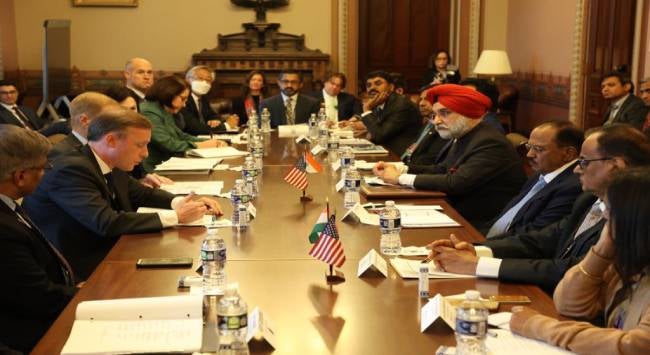Summary
Strategic ties between India and the United States could get a major lift from the new initiative on Critical and Emerging Technologies (iCET) unveiled in Washington by the two national security advisers, Ajit Doval and Jake Sullivan. Coming amidst the growing convergence of interests in the Indo-Pacific, the iCET is expected to strengthen India’s military, technological and economic capabilities that will allow Delhi to contribute more effectively to the construction of a stable regional balance of power.
India’s national security adviser Ajit Doval and his American counterpart Jake Sullivan unveiled a new road map for deeper military and techno-economic cooperation after their talks in Washington at the end of January 2023. If implemented with speed and purpose, the bilateral initiative on Critical and Emerging Technologies (iCET) could lend new strategic depth and widen the ambit of the strategic partnership between Delhi and Washington.
The idea was first articulated at the meeting between Indian Prime Minister Narendra Modi and United States (US) President Joe Biden on the margins of the Tokyo summit of the Quadrilateral Security Dialogue (Quad) in May 2022. The road map has since been fleshed out through intensive consultations between the two bureaucracies.
The scale and intensity of the new initiative is underlined by the kind of delegation that Doval led to Washington. He was accompanied by the top leadership of the Indian technology establishment. It included the Principal Scientific Advisor to the Indian government, Chairman of the Indian Space Research Organisation, Secretary of the Department of Telecommunications, Scientific Advisor to the Defence Minister, Director General of the Defence Research and Development Organisation and senior officials from the Ministry of Electronics and Information Technology.
On the US side, the Administrator of the National Aeronautics and Space Administration, Director of the National Science Foundation, Executive Secretary of the National Space Council and senior officials from the Department of State, Department of Commerce, the Department of Defence and the National Security Council joined Sullivan. The iCET has become the core of a transformed relationship that Delhi and Washington seek to build. They know that the new goals cannot simply be a government-to-government initiative and have mobilised top corporations on both sides that were present at an event organised by the US India Business Council addressed by Doval and Sullivan on 30 January 2023.
The iCET also involves collaboration in a range of areas, including artificial intelligence, quantum computing, semiconductors, 5G and 6G wireless infrastructure, and civilian space projects such as lunar exploration. A new task force has also been set up to promote greater collaboration between the universities and research institutes in the US and India to provide a solid collaborative research base to the iCET. All these possibilities will take time to roll out. However, Delhi and Washington highlight some early harvest possibilities on joint defence production. The initial focus is on exploring projects related to jet engines, artillery and munition-related technologies.
Doval and Sullivan announced one concrete measure – the manufacturing of a fighter jet engine in India. The General Electric Aerospace has applied for an export licence for jet engine production and phased transfer of technology to Indian entities. Washington promises to process this application expeditiously. This fits in nicely with India’s plans to modernise its rusty defence industrial and technology system. Media reports say the engine in question is a GE 414, which could power the next generation of indigenous fighters to be made in India.
High technology cooperation has long been a major focus of India-US relations. Early advances in India’s nuclear and space programmes in the 1950s and 1960s involved significant inputs from the US. But the US nuclear sanctions from the 1970s steadily made it harder to pursue high-technology cooperation. The historic civil nuclear initiative of 2005 began to open the doors for a renewed technological partnership. However, residual restrictions on technology transfer in Washington and India’s political ambivalence and bureaucratic inertia prevented the best use of the new possibilities. The iCET process, which will be monitored and driven from the Prime Minister’s Office in Delhi and the White House in Washington, will hopefully bring greater coherence to this round of technological engagement.
Lending urgency to the iCET is the new geopolitical dynamics. There has been a growing convergence of Indian and US interests in managing the security, economic and technological challenges presented by a rising and assertive China. India is also looking to reduce its over-dependence on Russian weapons and military technology and to produce more weapons at home. In his interaction with the media, Sullivan acknowledged that “geopolitical competition with China has been a feature of the India-US relationship now for more than a decade”. He added that the China factor has acquired a sharper edge in recent years. Sullivan underlined that the iCET is “one of a piece” with the AUKUS – the US pact with Australia and the United Kingdom to build nuclear-powered submarines for Canberra –and the Quad. The US’ grand strategy is to rapidly enhance the capabilities of its allies and partners in the Indo-Pacific and boost its ability to deter Chinese expansionism.
The key to the success of the India-US high-technology ambition lies in both sides overcoming the range of regulatory and policy obstacles that continue to limit cooperation. In the past, India has not been decisive in seizing the opportunities presented by the US partnership. It remains to be seen if Delhi can shake off its past political inhibitions and bureaucratic red tape to fully engage in intensive military and techno-economic collaboration with Washington.
. . . . .
Professor C Raja Mohan is a Visiting Research Professor at the Institute of South Asian Studies (ISAS), an autonomous research institute in the National University of Singapore (NUS). He can be contacted at crmohan@nus.edu.sg. The author bears full responsibility for the facts cited and opinions expressed in this paper.
Pic Credit: IndianEmbassyUS Twitter Account
-
 More From :
More From :
-
 Tags :
Tags :
-
 Download PDF
Download PDF



